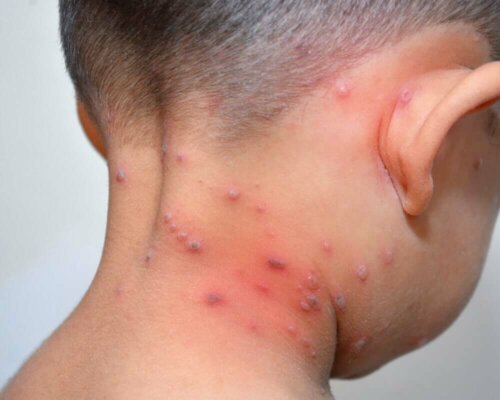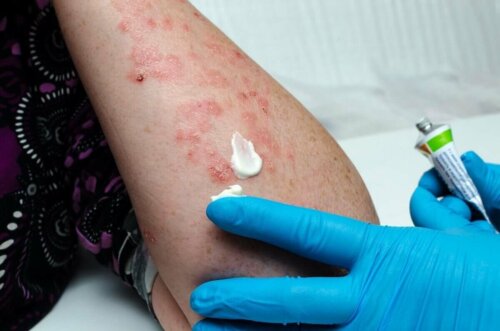Symptoms and Treatment of Herpes Zoster in Children


Written and verified by the dermatologist Maria del Carmen Hernandez
Herpes zoster in children, also known as shingles, is a rare viral infection caused by the reactivation of the varicella-zoster virus. The prognosis for this condition is usually good when the minor is healthy.
However, it’s necessary to diagnose and treat it in time to avoid complications. OK, but what are the causes? How do you recognize it? Continue reading to find detailed answers.
Causes of herpes zoster in children
Shingles can occur in both healthy children and those with underlying immunodeficiency. Its main cause is close contact with the varicella-zoster virus, which remains latent in the nervous system for the duration of a life. Thus, anyone who’s had chickenpox can also get shingles later on.
The appearance of this infection during childhood has to do with:
- Intrauterine Varicella-Zoster Virus (VZV) Infection. The increasing incidence of herpes zoster in otherwise healthy children may be due to a primary varicella infection in the uterus, where immunity isn’t fully developed.
- Live attenuated virus vaccination. Immune status at the time of primary infection is the most important determinant in childhood herpes zoster. Latent varicella-zoster virus (VZV) has been found in the dorsal root ganglia of children without a history of chickenpox and without epidermal involvement.
- Secondary to postnatal exposure to VZV at an early age. This probably happened during infancy, where the immune system wasn’t fully developed.
- About 3% of pediatric zoster cases occur in children with malignant neoplasms.
According to information published in the Journal of the American Academy of dermatology, chickenpox in early childhood is a risk factor for herpes zoster in children.

Read about Shingles – Symptoms, Diagnosis and Facts
Herpes zoster symptoms in children
In general, the evolution of this disease is milder in children — its average duration is 1 to 3 weeks. Those between the ages of 2 and 12 may be itchy and have sore lesions. However, there is no acute neuropathic pain, which is the hallmark of herpes zoster in adults.
The infection is often localized in areas such as the trunk and buttocks, although it can also appear on the arms, legs, or face. Every child has different symptoms but the most common clinical manifestations are:
- Skin hypersensitivity in the area where herpes zoster appears
- Mild rash, which appears after five days as little red spots that later turn into blisters
- Then, these blisters turn yellow and become dry
- A localized rash on one side of the body
- Finally, it disappears in a week or two
It’s important to differentiate herpes zoster from herpes simplex zosteriform. You can tell by the monomorphic vesicular lesions in the latter, which are more common in children.
Treatment of herpes zoster in children
Treatment options for shingles depend on a child’s age, their immune status, the duration of their symptoms, and their appearance. The goals of most treatments are to:
- Limit seriousness
- Limit the duration of pain
- Shorten the duration of a shingles episode
- Reduce complications
The first line of treatment for herpes zoster in children is oral acyclovir, administered four times a day. In addition, you can begin treatment with topical antibiotics and zinc sulfate supplements in order to prevent superinfections.
Children who develop ophthalmic herpes zoster should receive oral acyclovir. This is due to its documented effects on complications, such as anterior uveitis or stromal keratitis.

Self-prescribed medication precautions
Acetaminophen (paracetamol) is the preferred antipyretic agent. This is because of the association between aspirin and Reye’s syndrome (sudden-onset, life-threatening encephalopathy, and liver dysfunction).
It’s also due to an epidemiological link between ibuprofen and an increased risk of invasive group A streptococcal disease in the context of chickenpox, although not causally.
Do you know What’s Herpes Keratitis?
Important considerations
Herpes zoster in children is non-contagious but, despite this, anyone with this disease can transmit the chickenpox virus to those who’ve never had it. Researchers determined that such spread is only caused by direct contact with the blisters.
The symptoms of this infection may resemble other skin conditions. Finally, you must consult a doctor to obtain an accurate diagnosis.
All cited sources were thoroughly reviewed by our team to ensure their quality, reliability, currency, and validity. The bibliography of this article was considered reliable and of academic or scientific accuracy.
- Prabhu, S., Sripathi, H., Gupta, S., & Prabhu, M. (2009). Childhood herpes zoster: a clustering of ten cases. Indian journal of dermatology, 54(1), 62–64. https://doi.org/10.4103/0019-5154.48991
- Katakam BK, Kiran G, Kumar U. A Prospective Study of Herpes Zoster in Children. Indian J Dermatol. 2016;61(5):534-539. doi:10.4103/0019-5154.190121
-
Lamont, R. F., Sobel, J. D., Carrington, D., Mazaki-Tovi, S., Kusanovic, J. P., Vaisbuch, E., & Romero, R. (2011). Varicella-zoster virus (chickenpox) infection in pregnancy. BJOG: An International Journal of Obstetrics & Gynaecology, 118(10), 1155–1162. https://doi.org/10.1111/j.1471-0528.2011.02983.x
- Gershon AA, Breuer J, Cohen JI, et al. Varicella zoster virus infection. Nat Rev Dis Primers. 2015;1:15016. Published 2015 Jul 2. doi:10.1038/nrdp.2015.16
- Gershon AA, Chen J, Davis L, et al. Latency of varicella zoster virus in dorsal root, cranial, and enteric ganglia in vaccinated children. Trans Am Clin Climatol Assoc. 2012;123:17-35.
This text is provided for informational purposes only and does not replace consultation with a professional. If in doubt, consult your specialist.








